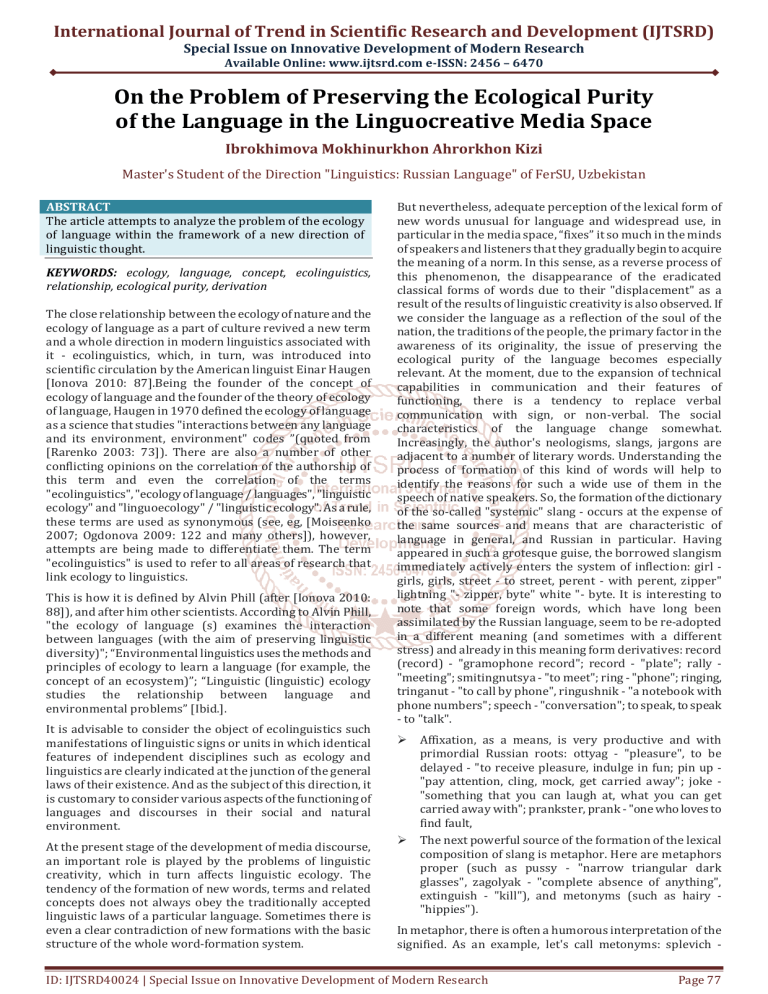
International Journal of Trend in Scientific Research and Development (IJTSRD)
Special Issue on Innovative Development of Modern Research
Available Online: www.ijtsrd.com e-ISSN: 2456 – 6470
On the Problem of Preserving the Ecological Purity
of the Language in the Linguocreative Media Space
Ibrokhimova Mokhinurkhon Ahrorkhon Kizi
Master's Student of the Direction "Linguistics: Russian Language" of FerSU, Uzbekistan
ABSTRACT
The article attempts to analyze the problem of the ecology
of language within the framework of a new direction of
linguistic thought.
KEYWORDS: ecology, language, concept, ecolinguistics,
relationship, ecological purity, derivation
The close relationship between the ecology of nature and the
ecology of language as a part of culture revived a new term
and a whole direction in modern linguistics associated with
it - ecolinguistics, which, in turn, was introduced into
scientific circulation by the American linguist Einar Haugen
[Ionova 2010: 87].Being the founder of the concept of
ecology of language and the founder of the theory of ecology
of language, Haugen in 1970 defined the ecology of language
as a science that studies "interactions between any language
and its environment, environment" codes ”(quoted from
[Rarenko 2003: 73]). There are also a number of other
conflicting opinions on the correlation of the authorship of
this term and even the correlation of the terms
"ecolinguistics", "ecology of language / languages", "linguistic
ecology" and "linguoecology" / "linguistic ecology". As a rule,
these terms are used as synonymous (see, eg, [Moiseenko
2007; Ogdonova 2009: 122 and many others]), however,
attempts are being made to differentiate them. The term
"ecolinguistics" is used to refer to all areas of research that
link ecology to linguistics.
This is how it is defined by Alvin Phill (after [Ionova 2010:
88]), and after him other scientists. According to Alvin Phill,
"the ecology of language (s) examines the interaction
between languages (with the aim of preserving linguistic
diversity)"; “Environmental linguistics uses the methods and
principles of ecology to learn a language (for example, the
concept of an ecosystem)”; “Linguistic (linguistic) ecology
studies the relationship between language and
environmental problems” [Ibid.].
It is advisable to consider the object of ecolinguistics such
manifestations of linguistic signs or units in which identical
features of independent disciplines such as ecology and
linguistics are clearly indicated at the junction of the general
laws of their existence. And as the subject of this direction, it
is customary to consider various aspects of the functioning of
languages and discourses in their social and natural
environment.
At the present stage of the development of media discourse,
an important role is played by the problems of linguistic
creativity, which in turn affects linguistic ecology. The
tendency of the formation of new words, terms and related
concepts does not always obey the traditionally accepted
linguistic laws of a particular language. Sometimes there is
even a clear contradiction of new formations with the basic
structure of the whole word-formation system.
But nevertheless, adequate perception of the lexical form of
new words unusual for language and widespread use, in
particular in the media space, “fixes” it so much in the minds
of speakers and listeners that they gradually begin to acquire
the meaning of a norm. In this sense, as a reverse process of
this phenomenon, the disappearance of the eradicated
classical forms of words due to their "displacement" as a
result of the results of linguistic creativity is also observed. If
we consider the language as a reflection of the soul of the
nation, the traditions of the people, the primary factor in the
awareness of its originality, the issue of preserving the
ecological purity of the language becomes especially
relevant. At the moment, due to the expansion of technical
capabilities in communication and their features of
functioning, there is a tendency to replace verbal
communication with sign, or non-verbal. The social
characteristics of the language change somewhat.
Increasingly, the author's neologisms, slangs, jargons are
adjacent to a number of literary words. Understanding the
process of formation of this kind of words will help to
identify the reasons for such a wide use of them in the
speech of native speakers. So, the formation of the dictionary
of the so-called "systemic" slang - occurs at the expense of
the same sources and means that are characteristic of
language in general, and Russian in particular. Having
appeared in such a grotesque guise, the borrowed slangism
immediately actively enters the system of inflection: girl girls, girls, street - to street, perent - with perent, zipper"
lightning "- zipper, byte" white "- byte. It is interesting to
note that some foreign words, which have long been
assimilated by the Russian language, seem to be re-adopted
in a different meaning (and sometimes with a different
stress) and already in this meaning form derivatives: record
(record) - "gramophone record"; record - "plate"; rally "meeting"; smitingnutsya - "to meet"; ring - "phone"; ringing,
tringanut - "to call by phone", ringushnik - "a notebook with
phone numbers"; speech - "conversation"; to speak, to speak
- to "talk".
Affixation, as a means, is very productive and with
primordial Russian roots: ottyag - "pleasure", to be
delayed - "to receive pleasure, indulge in fun; pin up "pay attention, cling, mock, get carried away"; joke "something that you can laugh at, what you can get
carried away with"; prankster, prank - "one who loves to
find fault,
The next powerful source of the formation of the lexical
composition of slang is metaphor. Here are metaphors
proper (such as pussy - "narrow triangular dark
glasses", zagolyak - "complete absence of anything",
extinguish - "kill"), and metonyms (such as hairy "hippies").
In metaphor, there is often a humorous interpretation of the
signified. As an example, let's call metonyms: splevich -
ID: IJTSRD40024 | Special Issue on Innovative Development of Modern Research
Page 77
International Journal of Trend in Scientific Research and Development (IJTSRD) @ www.ijtsrd.com eISSN: 2456-6470
"ephedrine, a medicine for the common cold, which is used
as a narcotic drug"; shaggy - "bald"; or metaphors with an
ironic connotation a basketball player is a "short man."
Compared with the three named (foreign borrowing,
affixation and metaphor), the share of other sources of the
formation of the lexical fund of youth slang is insignificant.
Borrowing thieves' argotisms: lawlessness - "complete
freedom, revelry"; ksiva - "documents"; wet - "beat, kill."
Antonomazia (proper noun as a common noun): Levis,
Louis "jeans"; Masha, Natasha - "girl"; listening to
Mendelssohn - "to be present at the marriage
ceremony"; to drive mumu - "to lie".
Synonymous or antonymic derivation (one of the
components of a phraseological unit is replaced by a
close or opposite word of the national language or
slang): to hammer in a joint - "fill a cigarette with a drug
for smoking" - to nail a joint - to nail a joint - to nail a
joint; get on a needle - "start using drugs on a regular
basis" - get hooked; add a needle - "teach someone to use
drugs" - add a screw - add a jeff; get off the needle - "stop
using drugs" - get off the needle - jump off the needle.
In addition, this series can be continued by describing such
linguistic manifestations as truncation of roots, addition of
roots, universalization, abbreviation, etc. These processes
are especially vividly observed in the media space, where
there is a "shift in communication towards nonenvironmental friendliness", which is confirmed by
"environmental disasters", for example, such as the influx of
foreign words, stylistic decline in speech, its jargonization,
vulgarization, stamping, the use of obscene words and
expressions, disregard for the formulas of politeness,
depletion of the vocabulary of native speakers.
If all structural, linguistic and stylistic norms are observed in
speech, but "the choice of goals is determined by anti-values
(moral, existential, aesthetic, etc.)," then such speech is a
manifestation of speech anti-culture, this concept is so
understood. In other words, the goal set also determines the
degree of environmental friendliness of speech. The degree
of environmental friendliness of speech should be
determined taking into account the goal of the performed
speech behavior and its linguistic implementation.
Bibliography:
[1] Ионова С. В. К вопросу о признаках экологичности
текстовой
коммуникации
//
Вестник
Волгоградского государственного университета.
Сер. 2., Языкознание. 2011.
[2]
Моисеенко А. В. Некоторые лингвоэкологические
особенности субстандартной синонимии в
английском и русском языках // Вестник
Челябинского государственного университета.
Серия «Филология. Искусствоведение». 2007. №
13. С.65–71.
[3]
Огдонова Ц.Ц. Концептуальные основания
лингвоэкологической
парадигмы
научных
исследований // Альманах современной науки и
образования. Тамбов: «Грамота», 2009.
[4]
Раренко М. Б. 2003.01.007. Хрестоматия по
эколингвистике: язык, экология и окружение. The
ecolinguistics reader: language, ecology a. / Ed. By Fill
a. A. P. Muhlhausler. L. N. Y., 2001. 296 p. //
Социальные
и
гуманитарные
науки.
Отечественная и зарубежная литература. Серия 6:
Языкознание. Реферативный журнал. 2003. № 1.
С.70–80.
ID: IJTSRD40024 | Special Issue on Innovative Development of Modern Research
Page 78


